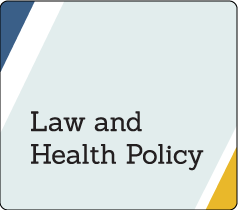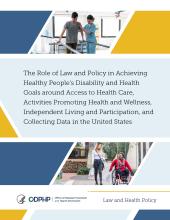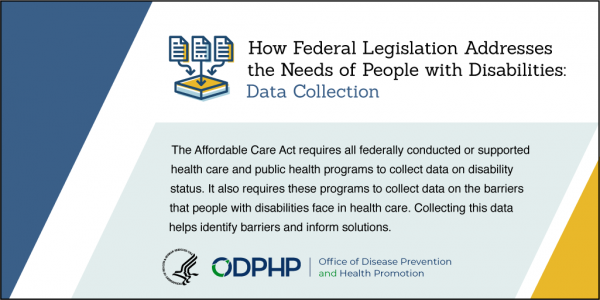This content was part of the Healthy People 2020 Law and Health Policy project, which ended in 2020.
Using Law and Policy to Promote Health for People with Disabilities in the United States
Laws and policies can help communities increase access to care and improve health for people with disabilities. Laws and policies also supported the achievement of ambitious national goals proposed by Healthy People 2020.
This is a summary of the report, The Role of Law and Policy in Achieving Healthy People’s Disability and Health Goals around Access to Health Care, Activities Promoting Health and Wellness, Independent Living and Participation, and Collecting Data in the United States, which was the second in a series of reports that highlighted the practical application of law and policy to improve health across the nation.
This report presented evidence-based policy solutions that community and tribal leaders, government officials, public health professionals, health care providers, lawyers, and social service providers could use in their own communities to improve health for people with disabilities. Success stories of law and policy in action, or Bright Spots, also illustrated how communities had already used law and policy to help meet their health improvement goals and achieve Healthy People’s objectives for people with disabilities.
Download Fact Sheet [PDF - 2.1 MB]
Key Finding: Federal Legislation has Evolved to Address the Needs of People with Disabilities
- The Americans with Disabilities Act (ADA) protects people with disabilities from discrimination in employment, public services, transportation, and telecommunications.
- The Rehabilitation Act strengthens the ADA by requiring states, religious organizations, and other organizations that take federal funding to follow the same accessibility standards as other public spaces.
- The Affordable Care Act made critical changes that addressed additional gaps in existing policies, including insurance provisions, data collection, and accessibility of health care facilities and services.
- The ADA’s “safe harbor” exemption allowed some insurance plans to treat people with disabilities differently. The Affordable Care Act helps fill this gap by prohibiting insurance companies from denying people coverage for pre-existing conditions and disabilities.
- Enforcement is needed to ensure that these laws are implemented in ways that improve the lives of people with disabilities. For example, the Department of Justice (DOJ) addresses barriers to care for people with disabilities by enforcing key federal legislation like the ADA, the Affordable Care Act, and the Rehabilitation Act.
Key Finding: Limited Accessibility to Community Resources Creates Barriers to Health and Well-Being
- Long-term services and supports (LTSS) are accommodations that can help people with disabilities fully participate in community life. This includes things like home-based modifications, equipment, and personal assistance services (PAS).
- Many people with disabilities aren’t able to get the LTSS they need because of cost.1 Insurance may not cover LTSS because they’re not considered “medically necessary.” This means that services like hearing aids, grab bars, and dental care often aren’t covered, so people must pay for them out-of-pocket or go without.2
- Most Americans don’t have the resources to pay for LTSS, including PAS. Two out of 3 Americans age 40 and older haven’t planned for their future long-term care needs, and only 1 in 4 understand how much PAS costs.3 Personal care assistants alone can cost more than $30,000 each year—about 75% of annual income for people age 65 and older.4
- Governments and organizations can make settings like community spaces, health care settings, and long-term care facilities more accessible through laws and policies that require accommodations for people with disabilities. For example, they could require accessible medical equipment or making community spaces accessible.
Key Finding: Engaging State and Local Initiatives Can Improve Outcomes for People with Disabilities
- State and local governments can use their own authorities to expand on federal laws and policies and improve the health and well-being of people with disabilities and make their communities more accessible for all. For example, states can expand health care services and coverage. And local governments and organizations can use these laws and policies as a framework to create healthy, accessible communities for all.
- Medicaid offers states a unique opportunity to improve health for people with disabilities. States can use Medicaid funds to improve training and licensing programs for personal care assistants and expand home-based PAS—and in turn, improve health for people with disabilities.
- States can also take steps to enhance accessibility for people with disabilities—including access to medical equipment. Advocates in Massachusetts are working with the state Medicaid program (MassHealth) on an accessibility plan that requires contracted providers to have accessible and available medical equipment.
- The national Money Follows the Person (MFP) program gives states and tribal partners federal matching funds to help people get long-term care in the setting of their choice, improving quality of life for many people with disabilities.
- State and local initiatives can continue to improve health for people with disabilities by educating individuals, institutions, and systems about existing laws that protect people with disabilities and collecting standardized disability data to help gain support for new policies and programs. States can also expand Medicaid coverage and cover different LTSS for people with disabilities under Medicaid.
Key Finding: Improving Disability Data Collection Can Inform Policy and Program Development
- Reliable data serve as a starting point for developing better policies and programs. Creating standardized questions about disabilities can help facilitate more accurate and nuanced disability data and better inform federal, tribal, state, and local initiatives.
- In 2008, the U.S. Census Bureau’s American Community Survey (ACS) added questions that measured 6 domains of functioning: seeing, hearing, mobility, cognition, self-care, and independence. The Affordable Care Act built on this work by requiring the Department of Health and Human Services (HHS) to collect additional data about people with disabilities—and report on barriers to health care or public health programs, accessible facilities, and the number of trained providers. Other federal data-gathering initiatives now ask these questions as well.
- Policymakers and professionals can use improved disability data to promote health in this long-understudied population. For example, the National Survey of Family Growth (NSFG) added the 6 ACS disability questions in 2011-2013. The NSFG data shows that women with disabilities were less likely to receive sexual health and contraceptive services.5 Policymakers can use these findings to develop policies and programs that meet these needs.
Key Finding: More Research is Needed to Address the Needs of People with Disabilities
- People with disabilities face significant health and socio-economic disparities. Compared to people without disabilities, people with disabilities have higher rates of conditions like diabetes, obesity, and depression. They’re less likely to get services like preventive dental care, cancer screenings, and prenatal care—and more likely to live in poverty, be food insecure, and have lower levels of education.6
- Formally recognizing this population as a disparity population could increase opportunities for federal support and funding—and additional research can help inform future directions for laws and policies at the federal, state, local, and tribal level.
- More disability research is needed both to inform the development and implementation of policies. Communities can use the “lessons learned” from other communities to create a chain reaction for improving disability and health.
Conclusion
Healthy People 2020 Disability and Health objective targets are ambitious but attainable. To meet these targets, federal, tribal, state, and local communities and organizations should leverage existing laws and policies—and use data collection and research to inform future laws and policies.
To help the Nation meet these health objectives, it is important to:
- Continue to implement, strengthen, and enforce federal laws and policies in ways that increase access to care for people with disabilities
- Facilitate community involvement for people with disabilities and increase access to resources like long-term services and supports
- Engage state governments and local organizations to expand services that improve overall health and well-being for people with disabilities
- Educate health care providers, institutions, and systems about the requirements of existing disability laws and policies
- Increase efforts to further collect data and conduct research aimed at achieving equity in health care and outcomes
- Explore ways to encourage more robust data collection and research—such as formally recognizing people with disabilities as a disparity population
Taking these steps will help ensure that people with disabilities in the United States are living in communities that adequately promote and support health.
Related Healthy People 2020 Objectives
- DH-1: Increase the number of population-based data systems used to monitor Healthy People 2020 objectives that include in their core a standardized set of questions that identify people with disabilities
- DH-4: Reduce the proportion of adults with disabilities aged 18 years and older who experience delays in receiving primary and periodic preventive care due to specific barriers
- DH-8: Reduce the proportion of adults with disabilities aged 18 and older who experience physical or program barriers that limit or prevent them from using available local health and wellness programs
- DH-13: (Developmental) Increase the proportion of adults with disabilities aged 18 years and older who participate in leisure, social, religious or community activities
1. Fox-Grage W. Medicaid: A last resort for people needing long-term services and supports. Washington (DC): AARP Public Policy Institute; 2017 Mar; 4 p.
2. Medicare, 42 C.F.R. Sect. 411.15
3. The Long-Term Care Poll. Long-term care in America: View on who should bear the responsibilities and costs of care [Internet]. Chicago (IL): Associated Press-NORC Center for Public Affairs Research; 2014-2018, cited 2017 Jun 8. Available from: http://longtermcarepoll.org.
4. Fox-Grage W. Medicaid: A last resort for people needing long-term services and supports. Washington (DC): AARP Public Policy Institute; 2017 Mar; 4 p.
5. Wu JP, McKee MM, McKee KS, Meadre MA, Plegue M, Sen A. Female sterilization is more common among women with physical and/or sensory disabilities than women without disabilities in the United States. Disabil Heatlh J. 2017;10:400-5.
6. U.S. Department of Health and Human Services, Office of Disease Prevention and Health Promotion, HealthyPeople.Gov. Topics & Objectives: Disability and health [Internet]. Washington (DC): 2014, cited 15 Sept. 2017. Available from: https://www.healthypeople.gov/2020/topics-objectives/topic/disability-and-health.



